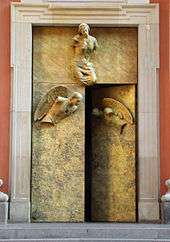Jesuit Church, Warsaw
The Jesuit Church (Polish: Kościół Jezuitów), also known as Church of the Gracious Mother of God (Kościół Matki Bożej Łaskawej), is an ornate church within the Old Town precinct in Warsaw, Poland. The temple stands on Świętojańska Street, adjacent to St John's Cathedral, and is one of the most notable mannerist-style churches in Warsaw.
| Church of the Gracious Mother of God | |
|---|---|
 Jesuit Church, rebuilt after World War II. | |

| |
| General information | |
| Architectural style | Polish Mannerism |
| Town or city | Warsaw |
| Country | Poland |
| Construction started | 1609 |
| Completed | 1626 |
| Demolished | 1944 |
| Client | Society of Jesus |
| Design and construction | |
| Architect | Jan Frankiewicz |
History
The Jesuit Church was founded by King Sigismund III Vasa and Podkomorzy Andrzej Bobola (the Old) at Piotr Skarga's initiative, in 1609, for the Jesuits. The main building was constructed between 1609 and 1626 in the Polish Mannerist style by Jan Frankiewicz.[1]

In 1627 the church was encompassed with three chapels,[2] and in 1635 Urszula Meyerin, a great supporter of the Society of Jesus, was buried within. Meyerin funded a silver tabernacle for the church.[3] She was also King Sigismund III's mistress, and was politically influential. Her grave was plundered and destroyed by the Swedes and Brandenburg Germans, in the 1650s, during the Deluge.[3]
A vestibule was added to the interior of the temple in 1633, and a choir was added three years later.[4] An altar made of silver was installed by Cardinal Charles Ferdinand Vasa in the 1640s.[5] The interior of the church was damaged and looted in 1656.[4]
An icon of Our Lady of Graces (Matka Boża Łaskawa), a gift from the Pope Innocent X, was introduced to the church and crowned in 1651. Its veneration has been growing, especially since the epidemic in 1664, when Blessed Virgin Mary was believed to save the city.[6]
In later years the building became more and more ornate, with baroque furnishings and marble altars and floors. Two more chapels were added. When the order of Jesuits was dissolved in 1773, the church changed ownership several times.[4] For some time it was a school church, later it was demoted to the role of the magazine of church furnishings, and then it was given to the order of Piarists. The Jesuits did not get the church back until the end of the First World War. In the 1920s and 1930s the church was renovated.
During World War II, after the Germans suppressed the Warsaw Uprising, they razed the Jesuit Church to the ground.[7] [8][9] All that remained of the four-hundred-year-old edifice was a great pile of rubble.[7][8] Between the 1950s and 1973, the church was rebuilt in a simplified architectural style.
Interior
The facade is Mannerist, although the interior is completely modern, because very few of the original furnishings of the church were preserved. Inside, there are preserved fragments of a tomb monument of Jan Tarło carved by Jan Jerzy Plersch[4] in white and black marble in 1753, together with reconstructed epitaphs of Sarbiewski, Konarski, Kopczyński and Kiliński. A painting of Our Lady of Grace brought to Poland in 1651 by bishop Juan de Torres as a gift from Pope Innocent X is also displayed, along with a preserved wooden crucifix from 1383, a baroque sculpture of Our Lady of Grace, from the beginning of the 18th century, and a stone sculpture of a laying bear from the half of 18th century.[2][4]
Burials
- Karol Ferdynand Vasa
- Maciej Kazimierz Sarbiewski (1595–1640), Europe's most prominent Latin poet of the 17th century.+
Memorial plaque
See also
- List of mannerist structures in Central Poland
- St. Jacek's Church in Warsaw
- Warsaw Old Town
References
- "Church of Our Lady of Grace". eGuide / Treasures of Warsaw on-line. Retrieved 2009-03-24.
- "O kościele (Official website)". www.laskawa.pl (in Polish). Retrieved 2009-03-24.
- "Metresa z różańcem w dłoni (Mistress with a rosary in her hand)". www.toporzel.gower.pl (in Polish). Archived from the original on March 1, 2009. Retrieved 2009-03-24.
- "Jesuits' Church (The church of Our Lady of Grace)". naszemiasto.pl. Archived from the original on 2013-05-01. Retrieved 2009-03-24.
- Jerzy Lileyko (1984). Życie codzienne w Warszawie za Wazów (Everyday Life in Warsaw under the Vasas) (in Polish). Warsaw. ISBN 83-06-01021-3.
- Internetowa Liturgia Godzin
- "Sanktuarium Matki Bożej Łaskawej - Patronki Warszawy". www.archidiecezja.warszawa.pl (in Polish). Archived from the original on 2013-05-01. Retrieved 2009-03-24.
- "Kościół pw Najświętszej Marii Panny Łaskawej". www.warszawa1939.pl (in Polish). Retrieved 2009-03-24.
- Maria Kwiatkowska (1978). Katedra Św. Jana (St. John's Cathedral) (in Polish).
Images
 in 1627
in 1627 in the 1920s
in the 1920s in 2006
in 2006
External links
| Wikimedia Commons has media related to Our Lady of Graces church in Warsaw. |
- Church of Our Lady of Grace
- Description and photos of the church
- (in Polish) Before the Second World War
- (in Polish) Matka Boża Łaskawa (Our Lady of Grace)
- sztuka.net Pictures of the church shortly after the war (the pile of rubble on the left of St. John's Cathedral).